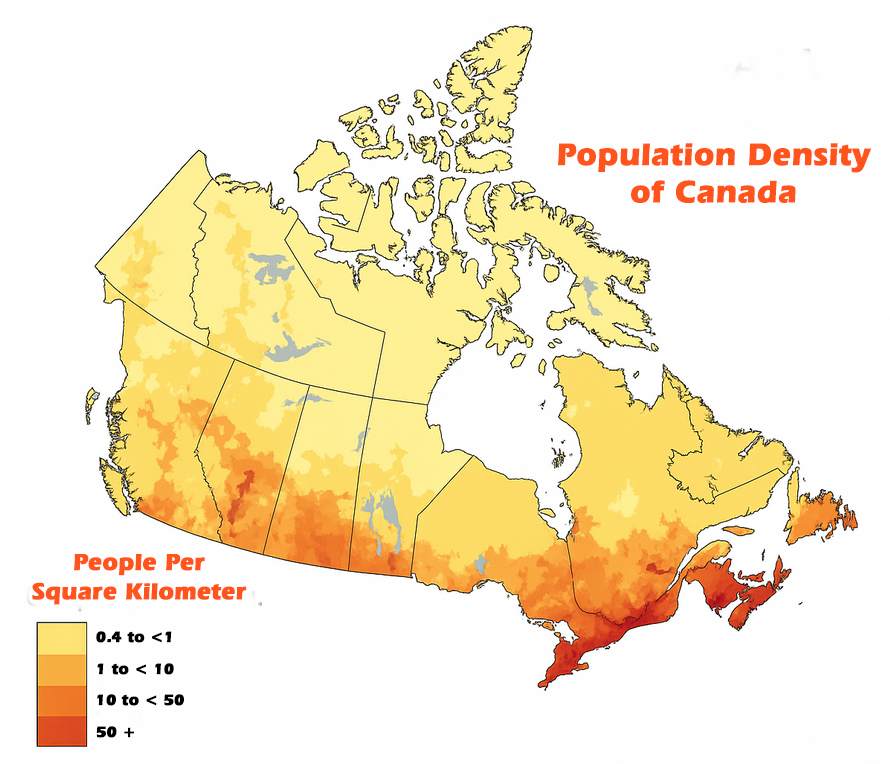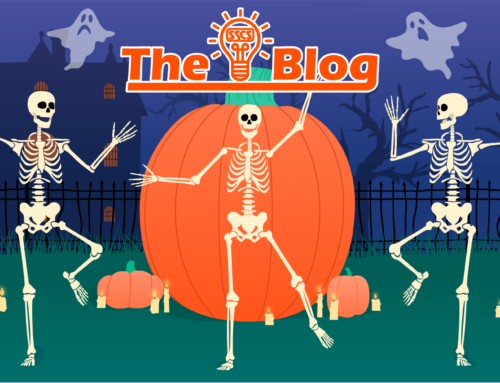
Remote Places, Canadian Spaces
Canada looks unassuming on the surface, but its hidden side is full of mystery and mythic legend.
When you’re name-checking the most mysterious places in the world, Canada doesn’t make the top of the list, or anywhere on the list, really. The land of Keanu Reeves, Michael J. Fox, and Ryan Gosling just doesn’t seem primed for the weird and scary. It’s cozy (if you’re inside in winter). Its big cities are friendly and inviting. Ice fishing and hockey rule as all-Canadian national pastimes. Not much malevolent about that.
There’s another side to Canada, though, and comes right out of the fact that its landscape is dominated by remote spaces. Extremely remote. Specifically, there’s 3.51 million square miles of land, and only 20 percent of it is populated—70 percent of that being within 100 miles of the U.S. border. Take a look:

Two types of uninhabited stretches[1] dominate the U.S.’s neighbor to the north. The first is the Interior Plains that span its center, across the provinces of Manitoba, Saskatchewan, and Alberta. They are flat and seem endless; crops and fields all begin to look the same after a while. You wouldn’t think you could get lost in something so open—but it’s easier than you think.
At the other end of the isolation spectrum is Canada’s densely wooded swaths, primarily consisting of the Boreal Forest that stretches coast to coast across nearly 60 percent of the country’s landmass. Take a wrong turn, and you might be walking—or driving—for days. All the trees start to look the same. And you never know what’s huddling behind them.
This overabundance of isolated places give Canada the mysterious allure we were talking about earlier. It’s hard to say what you might run into a couple of hundred miles out in the boonies, and the verdant possibilities have fired up the collective Canadian imagination. No surprise then, that the country is home to a surprising number of legends, and enough imaginary creatures to fill a small museum.
On the kinder, gentler side of the spectrum is the White Buffalo Woman, a figure revered by the indigenous people of the plains, especially in the area surrounding Winnipeg, Manitoba. She is a symbol of peace, prophecy, and spiritual renewal.
Somewhere in the middle is Sasquatch, a.k.a Bigfoot. He’s kind of a lost soul wandering around looking for…well, we’re not sure, but he does have a habit of running away from human beings, that’s for sure.
On the darker side of mysterious is the Wendigo, a rather terrifying cryptid with no socially redeeming characteristics, something right out of a folk horror story, like this one. Unlike Bigfoot, the Wendigo will probably run towards you, at which time you should head in the other direction—fast.

This isn’t to say that the more remote spots of Canada are all regional myths and legends. From a retail perspective, being in an isolated area sometimes results in local products that, while not quite mysterious, have developed in unique ways.
Now we aren’t talking about Canadian retail giants like Canada Dry, or the quirky ketchup chips that began as a taste experiment and ended up becoming a national phenomenon. No. we’re talking about snacks and other c-store fare that are less mainstream.
From the Great Plains in Canada’s heartland, comes Bison Jerky. Not unlike the White Buffalo Woman, bison jerky traces its roots to indigenous traditions across the Canadian Prairies, where bison were central to survival and culture. In that way, it’s definitely a snack that’s tied into the land on which it originated.
Our next example, potato fudge, comes from Prince Edward Island, up in the remote Canadian northeast, a province perfectly positioned on its own land mass to develop quirky food with a regional stamp. A sweet confection made with mashed potatoes, chocolate, butter, and sugar, the potato acts as a binder and texture enhancer, giving the fudge a smooth, creamy consistency without tasting like potato.
Our last example for this post takes us to French-speaking Quebec, the heart of Canada’s maple syrup industry, where influences can take some time to cross into English-speaking areas. This was once true of the provincial maple syrup candies made by boiling pure maple syrup until it crystallizes into a soft confection, but now the maple leaf-shaped treats are available nationwide at retail outlets including c-stores.
Speaking of c-stores, while we’re focused on Canada, SSCS would like to take this opportunity to give a shout out to our customers above the 49th parallel, including convenience retailing leader, Couche-Tard. Even if, as an operator, you don’t carry particularly exotic snacks, you’ll find the speed and profitability that comes with computerized inventory tracking and management applies to any operator. There’s nothing mythical about it. Give us a call at (800) 927-7277 and we’ll show you how to operate like a legend.
[1] Not counting the arctic tundra of the far north. But it can get a little spooky up there, too.






Leave A Comment